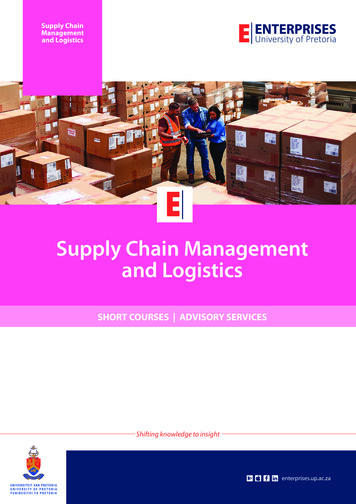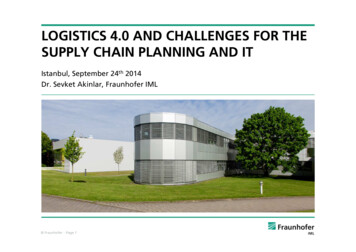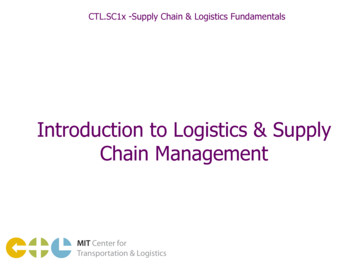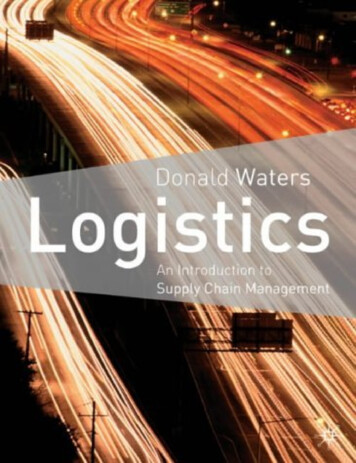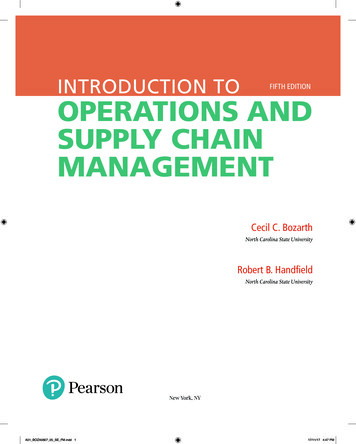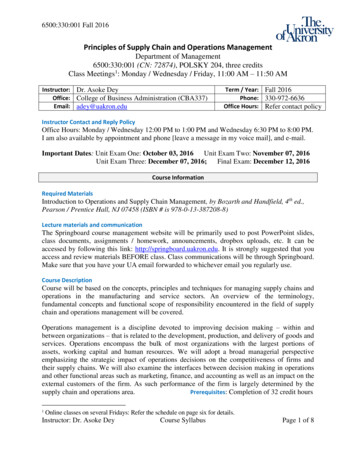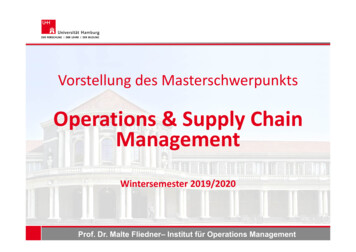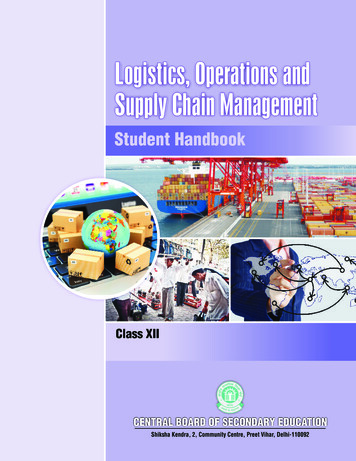
Transcription
Logistics, Operations andSupply Chain ManagementStudent HandbookClass XIIHkkjrCENTRAL BOARD OF SECONDARY EDUCATIONShiksha Kendra, 2, Community Centre, Preet Vihar, Delhi-110092
Logistics, Operationsand Supply ChainManagementStudent HandbookCLASSXIIHkkjrCENTRAL BOARD OF SECONDARY EDUCATIONShiksha Kendra, 2, Community Centre, Preet Vihar, Delhi-110092
Logistics, Operations and Supply Chain ManagementStudent Handbook, Class XIIPrice: First Edition: February 2017, CBSECopies:Paper used: 80 Gsm CBSE Water Mark White Maplitho"This book or part thereof may not be reproduced byany person or agency in any manner."Published By:The Secretary, Central Board of Secondary Education,Shiksha Kendra, 2, Community Centre, Preet Vihar,Delhi-110092Design, Layout:Multi Graphics, 8A/101, WEA Karol Bagh,New Delhi-110005Printed By:
Eiw.kZ izHkqRo&laiUulektoknhiaFkfujis{kyksdra kkRedx.kjkT;cukusdsfy,]rFkkmldsleLrukxfjdksa r]fo'okl]/eZvkSjmiklukdhLora a usokyhca/qrkc kusdsfy,n ladYigksdjviuhbllafo/kulHkkesa vktrkjh[k26uoEcj]1949bZñdks,rn gSaA1- 311977)ls¶izHkqRo&laiUuyksdra kkRedx.kjkT; dsLFkkuijizfrLFkkfirA2- 311977)ls¶jk"Vªdh,drk kSjjk"Vªxkudkvknjdjs([k)Lora kn'kksZa dksân;esa svkSjvkg okufd,tkusijjk"Vªdhlsokdjs(Ä)HkkjrdslHkhyksxksa esa lejlrkvkSjlekuHkzkr ijvk/kfjrlHkhHksnHkkolsijsgksa],slhizFkkvksa dkR;kxdjstksfL k;ksa hijaijkdkegÙole Zrou] zk.khek kdsizfrn;kHkkoj[ks(t)oSKkfudn ldjs( )lkoZtfudlaifÙkdkslqjf{krj[ksvkSjfgalklsnwjjgs( k)O;fDrxrvkSjlkewfgdxfrfof/;ksa dslHkh{ks kksa esa mRd"kZdhvksjc usdklrriz;kldjsftllsjk"Vªfujarjc rsgq,iz;RuvkSjmiyfC/dhubZmapkb;ksa u;e]2002dh/kjk4}kjkizfrLFkkfirA
THE CONSTITUTION OF INDIAPREAMBLEWE, THE PEOPLE OF INDIA, having solemnly resolved to constitute India into a 1SOVEREIGNSOCIALIST SECULAR DEMOCRATIC REPUBLIC and to secure to all its citizens :JUSTICE, social, economic and political;LIBERTY of thought, expression, belief, faith and worship;EQUALITY of status and of opportunity; and to promote among them allFRATERNITY assuring the dignity of the individual and the2 unity and integrity of the Nation;IN OUR CONSTITUENT ASSEMBLY this twenty-sixth day of November, 1949, do HEREBY ADOPT,ENACT AND GIVE TO OURSELVES THIS CONSTITUTION.1.Subs, by the Constitution (Forty-Second Amendment) Act. 1976, sec. 2, for "Sovereign Democratic Republic” (w.e.f. 3.1.1977)2.Subs, by the Constitution (Forty-Second Amendment) Act. 1976, sec. 2, for "unity of the Nation” (w.e.f. 3.1.1977)THE CONSTITUTION OF INDIAChapter IV AFUNDAMENTAL DUTIESARTICLE 51AFundamental Duties - It shall be the duty of every citizen of India(a) to abide by the Constitution and respect its ideals and institutions, the National Flag and the NationalAnthem;(b) to cherish and follow the noble ideals which inspired our national struggle for freedom;(c) to uphold and protect the sovereignty, unity and integrity of India;(d) to defend the country and render national service when called upon to do so;(e) to promote harmony and the spirit of common brotherhood amongst all the people of India transcendingreligious, linguistic and regional or sectional diversities; to renounce practices derogatory to the dignity ofwomen;(f)to value and preserve the rich heritage of our composite culture;(g) to protect and improve the natural environment including forests, lakes, rivers, wild life and to havecompassion for living creatures;(h) to develop the scientific temper, humanism and the spirit of inquiry and reform;(i)to safeguard public property and to abjure violence;(j)to strive towards excellence in all spheres of individual and collective activity so that the nation constantlyrises to higher levels of endeavour and achievement;1(k) who is a parent or guardian to provide opportunities for education to his/her child or, as the case may be,ward between age of 6 and 14 years.1.Subs. by the Constitution (Eighty - Sixth Amendment) Act, 2002
PrefaceEconomic liberation through systemic reforms made by the Government has ushered,in India, an era of enhanced opportunities. As foreign investment and new businessesare entering the Indian market, there has been a greater focus on making systemsefficient and reducing wastages. To meet the need of making supply chains reliable,efficient and sustainable, the field of Logistics, Operations and Supply ChainManagement has assumed a greater degree of importance in today’s world.The demand for focused supply chain services has been fueled by industries with a highpropensity to outsource, namely, automobiles, consumer packaged goods, hi-tech,telecom and retail amongst others. Movement of basic commodities for both domesticconsumption and export/import has led to increase in multimodal and bulktransportation and proliferation of ports and related services. The Indian logistics sectorhas grown at a healthy 15% in the last five years and is expected to continue to growfurther.To address the need of economies for skilled manpower, the CBSE has undertaken theproject of introducing competency based Vocational Education in its affiliated schools.As a sequel to this, a new course on Transport Systems and Logistic Management isbeing launched. This will help students to either join the industry after Class XII orpursue higher education in this field. The Student Handbook deals with the concept andobjectives of logistics, management of inventory and freight and, the use of informationtechnology for inventory management. The emerging issues in supply chainmanagement and logistics are also discussed.The Board is grateful to the members of the Course Committee for their advice,guidance and commitment towards development of the course and this handbook. Weare indeed indebted to these academic advisors who have lent us the benefit of theirrich and insightful experience. I would like to appreciate Vocational Education Cell,CBSE for coordinating and successfully completing the handbook.R. K. Chaturvedi, IASChairman, CBSE
AcknowledgementsAdvisorslSh. R. K. Chaturvedi (IAS), Chairman, CBSElSh. K. K. Choudhury, Controller of Examinations, CBSEContent Developed BylDr. ShardulChaubey, Assistant Registrar, BHU and Former Reader,School of Management Sciences, Varanasi (U.P.) - (Convener)lMs. IndraniSen Gupta, Assistant Professor, AURO University, Surat,GujratlDr. AchintyaSinghal, Assistant Professor, Department of ComputerScience, BHU, Varanasi (U.P.)lDr. IrfanKhan, Assistant Professor, Faculty of Management Sciences,BHU, Varanasi (U.P.)lProf. Rachana Dubey, Principal, Arya Mahila P.G. College, VaranasiEditing & CoordinationlDr. Biswajit Saha, Additional Director (V.E.), CBSE
ContentsUNIT - 1Logistics and System Concept, Objectivesand Role of Logistics1UNIT - 2Inventory Management25UNIT - 3Freight Management40UNIT - 4Logistics Management and Information Technology55UNIT - 5Emerging Issues in SCM and Logistics88
UNIT 1Logistics and System Concept, Objectivesand Role of Logistics1.0Unit Overview & Description1.1Introduction1.2Logistics: A System Concept1.3Logistics Functions1.4Logistics Management - Objectives1.5Role of Logistics in the Supply Chain1.6Transport Corporation of India - Indian Road Freight Index1.7Catalysts for Outsourcing Trends1.8Benefits of Logistics Outsourcing1.9Third Party Logistics1.10Fourth Party Logistics1.11Career & Growth in Logistics and Supply Chain1.12Summary1.0Unit Overview & DescriptionThe unit is an attempt to give idea how logistics works as a system. It also helps tounderstand about the different elements in logistics system. It also provide an insight aboutobjective and role of logistics in supply chain. Third party and fourth party logistics along withcareer and growth in logistics and supply chain is expressed in brief to tell its utility.Knowledge and Skill OutcomesThe Unit is expected to impart the following knowledge and skill:çUnderstand the concept of logistics as a system.çExposure to different elements of logistics system.çAssist to understand the objectives of logistics management & its role in supply chain.çUnderstanding to know third party logistics and fourth party logistics.çProvides exposures about career & growth in supply chain area.Resource Material1.Coyle, John J., Edward J. Bardi, and C. John Langley, Jr., The Management ofBusiness Logistics: A Supply Chain Perspective, Mason OH: South-WesternThomson Learning (2013).2.Donald J. Bowersox and David J. Closs, Logistical Management: The Integrated SupplyChain Process, Tata Mc Graw-Hill Publishing Company Limited, New Delhi (2004).3.Sople, Vinod V., Logistics Management: The Supply Chain Imperative, Pearson, NewDelhi (2010).1Logistics, Operations and Supply Chain Management
Learning OutcomesUnit ILogistics and System Concept,Objectives and Role of LogisticsOutcomes1.1Introduction.Explain logistics with certain citationslike Mumbai dabbawala.1.2Logistics: A system concept.Discuss logistics as system.1.3Logistics functions.Write down the different elements oflogistics.1.4Logistics management - Objectives.Discuss the important objectives oflogistics management.1.5Role of logistics in supply chain.What is the role of logistics in supply chain.1.6TCI - Indian road freight index.Understand outsourcing.1.7Catalyst for outsourcing trends.What are the catalyst for outsourcing.1.8Benefits of logistics outsourcing.Discuss benefits of logistics.1.9Third party logistics.Understand 3 PL.1.10Fourth party logistics.Understand 4 PL.1.11Career and growth in logistics andsupply chain.Different career options of logisticsand supply chain.Assessment PlanUnit IAssessmentMethodTopic1.1IntroductionExercise: Question &Answer, T & F1.2and1.3Logistics: A systemconceptLogistic functionsExercise: T & F,Question & Answer,Match the following1.4Logistics management- objectivesExercise: T & F1.5,1.6,1.7,1.8,1.9,and1.10Role of logistics in theExercise: Question &supply chain,Answer, T & FTCI - Indian road freightindex.Catalysts for outsourcingtrends,Benefits of logisticoutsourcing,3 PL and 4 PL1.11Career & growth inExercise: T & Flogistics & supply chain.2Time PlanRemarks
1.1IntroductionLogistics DefinedThe word Logistics traces its origin to the Greek word logistikos and the Latin wordlogisticus, meaning the science of computing and calculating. In ancient times, the term wasfrequently used in connection with the art of moving armies and supplies of food andarmaments to the war front. The use of this word can be traced back to the seventeenthcentury in the French army. But during World War II, logistics gained importance in armyoperations as a term referencing the movement of supplies, men and equipment across theborder. The US army officially used the word "logistics" after World War II. Today logisticshas acquired a wider meaning and is used in business to refer to the movement of rawmaterials from suppliers to the manufacturer and, finally, the movement of finished goods tothe consumers.Logistics is also referred to as a physical distribution. Philip Kotler defines logistics as"Planning, implementing, and controlling the physical flows of materials and finished goodsfrom point of origin to point of use to meet the customers need at a profit." The AmericanCouncil of Logistics Management defines logistics as "the process of planning,implementing and controlling the efficient, cost effective flow and storage of raw materials,in process inventory, finished goods and related information from point of origin to point ofconsumption for the purpose of conforming to customers requirements."Logic in Logistics for 30 Minutes PizzaFigure 1.1: Pizza from the Angle of Logistics3Logistics, Operations and Supply Chain Management
Ideally, the time taken for registering the order should be one minute. After that the pizzagoes to the guy in the "make line". He takes two minutes, and then oven time is five minutes.When the pizza comes out of the oven it is inspected. One minute goes into quality checkand packing. Another minute goes in checking the route and confirming the order one lasttime.The moment he is leaving, the delivery boy shouts the out-of-the-door time, which isnormally between 10 and 12 minutes. Then everybody yells out "drive safe". When hereturns he punches the time in. At the end of the day the average delivery time for all hisorders is checked. This helps the manager figure out which orders were not delivered intime. The next day, the store manager calls each one of those whose orders got delayed andapologizes.The essence is process sequencing, just-in-time inventory availability, and timemanagement for the success in this service operation logistics.Review Question1. Discuss the definition of logistics as given by American Council of logisticsmanagement.Dabbawalas of MumbaiFigure 1.2: Dabbawalas in ActionDabbawalas of Mumbai offer a reliable fool proof logistics system of delivering lunch boxesto over 200,000 office employee every day without mix up of having the wrong tiffin going tothe wrong office or arriving late, irrespective
1 Logistics, Operations and Supply Chain Management 1.0 Unit Overview & Description 1.1 Introduction 1.2 Logistics: A System Concept 1.3 Logistics Functions

